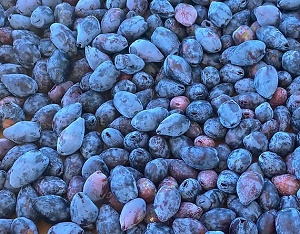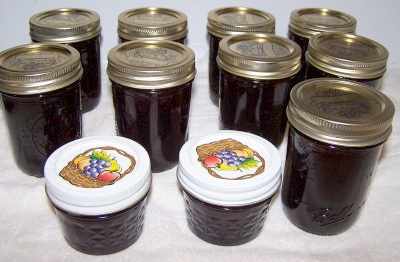
Looking for Haskaps: What are they, where to find them and how to use them in 2025? Scroll down this page and follow the links. And if you bring home some fruit or vegetables and want to can, freeze, make jam, salsa or pickles, see this page for simple, reliable, illustrated canning, freezing or preserving directions. There are plenty of other related resources, click on the resources dropdown above. If you are having a hard time finding canning lids, I've used these, and they're a great price & ship in 2 days.
If you have questions or feedback, please let me know! There are affiliate links on this page. Read our disclosure policy to learn more.
Haskaps: What are they, where to find them and how to use them
 Haskaps
Haskaps
What are they, where to find them and how to use them
Haskaps are similar to, but not related to blueberries, but they are oblong berries that are blue! They are actually related to honeysuckle,(Lonicera caerulea) and go by other names.
Taste and description
- They are edible with an unusual sweet and tart flavor, described as a cross between raspberries and blueberries.
- They are shrubs that typically grow to a height of 3 to 5 feet (1 to 1.5 m.). The plant produces a 1-inch (2.5 cm.), oblong, blue-colored berry.
- They are said to have a higher level of antioxidants than blueberries
- Each plant produces 1 lb to 10 lbs of berries annually and the plants live 50 years plus.
- Since they are resistant to both disease and pests, they are ideal for organic gardening
Where are Haskaps grown?
Haskaps are native to cool temperate Northern Hemisphere areas such as Alaska, the northern Midwestern states, Canada, Japan, Russia, and Poland. Of course, they may also be grown in similar climates to which they are not native. They are very cold-hardy and can survive temperatures down to -55 degrees Fahrenheit (-48 C.).
You can get your own haskap plants to grow in your yard here.
To find farms with Haskaps (also called Honeyberries!) see below:
Alaska
Minnesota
Missouri
Pennsylvania
Canada
Alberta
- Edmonton area of Alberta,
-
Search Results
Web results
Southwest Alberta
British Columbia
Manitoba
Ontario
Saskatchewan
When are Haskaps ripe?
Haskaps are ripe in the early Spring, far ahead of blueberries and Saskatoons. Keep in mind, the actual ripening dates and even the order can vary considerably from farm to farm, year to year, state to state; so take this as general order!
Other names for Haskaps
- honeyberries
- blue-berried honeysuckle,
- Fly honeysuckle,
- deepblue honeysuckle, and
- sweetberry honeysuckle
Berries that are similar to Haskaps
- Aroniaberries - also callled Chokecherries
- Bilberries - smaller cousins of the blueberry in Europe
- Blaeberry in Scotland and Ireland, smaller, intense flavor; like a bilberry-
- Huckleberries - larger blueberries, a bit less sweet, common to the northern US and Canada
- Saskatoons - Canadians know about Saskatoons. They are native to western Canada and the northwest of the U.S.. They are larger, a bit less sweet; almost identical to a Huckleberry, with a hint of apple.
- Serviceberries - another name for Saskatoons
- Whorlberry or whortleberry grown in the United Kingdom. Much like a bilberry.
Haskap Recipes - Cooking and Canning Haskaps
Being similar in many ways to blueberries, most blueberry recipes work well with Haskaps.
- The world's best Blueberry pie, recipe and directions and illustrated!
- Blueberry buckle coffee cake: illustrated directions for this great crumb-topping blueberry coffee cake
- Other easy directions to make blueberry desserts: cobblers, etc.
Canning and freezing Haskaps:

- How to Freeze Blueberries
- How to Can Blueberries
- How to Make Homemade Blueberry Jam
- How to make blueberry jelly
- How to make and can blueberry syrup (it works for strawberries, raspberries and blackberries, too)
- blueberry pie filling to use later,
- blueberry butter
Looking for canning equipment and supplies?
Water bath canner with a jar rack
Pressure canners for gas, electric and induction stoves: Presto 23Qt or T-fal 22Qt
Canning scoop (this one is PERFECT)
Ball Blue book (most recent version)
Jars: 8oz canning jars for jams
Find Other types of farms:
Farm markets and roadside stands
Road trips and camping resources
Local Honey, apiaries, beekeepers
Consumer fraud and scams information
Home canning supplies at the best prices on the internet!
Maple Syrup Farms, sugarworks, maple syrup festivals
Environmental information and resources
Farms For Your Event for birthday parties, weddings, receptions, business meetings, retreats, etc.
Festivals - local fruit and vegetable festivals
Get the
most recent version of
the Ball Blue Book
With this Presto 23 quart pressure canner and pressure cooker, you can "can" everything, fruits, vegetables, jams, jellies, salsa, applesauce, pickles, even meats, soups, stews. Model 01781

You can make jams, jellies, can fruit, applesauce, salsa and pickles with water bath canners, like this Granite Ware 12-Piece Canner Kit, Jar Rack, Blancher, Colander and 5 piece Canning Tool Set

